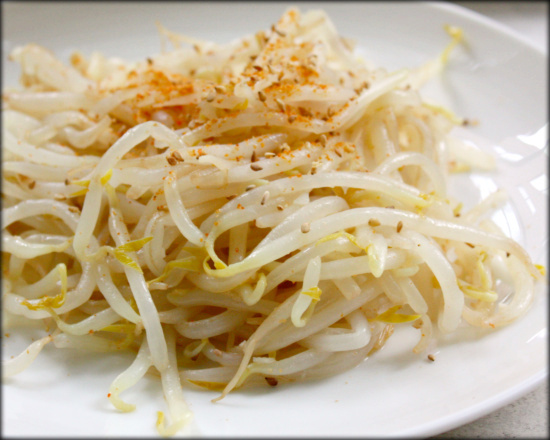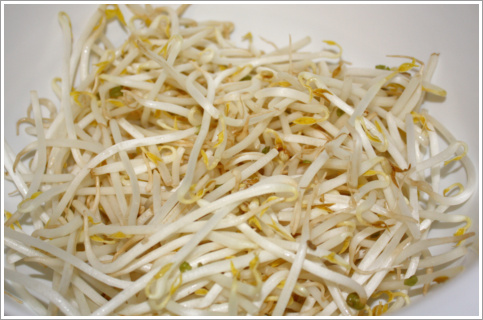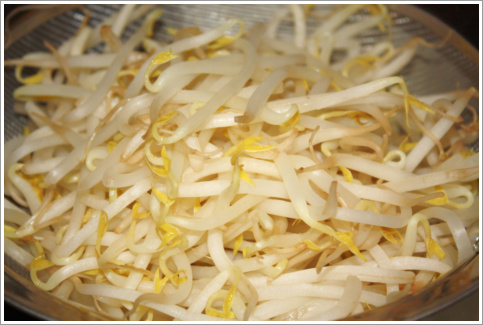All those side dishes you get when you eat at a Korean restaurant? Those dishes, along with the seemingly infinite number of other Korean side dishes, are collectively called banchan. And many of those banchan are used to make traditional bibimbap. I made No-Cook Vegan Bibimbap last week, but now that the temperature has gone down a little bit in NYC, I’m hankering for a traditional bibimbap. So this week, I will prepare some of the vegetable banchan required for the recipe. Sukju Namul (or Sookju Namul), Korean Seasoned Mung Bean Sprouts, is first on the list.
I love Sukju Namul. Whenever there was a traditional Korean function, my grandmother always made this. There are many ways to serve this dish. You can simply serve it with warm rice. You can add it as an ingredient in bibimbap. You can also put it in Moo Guk (Korean radish soup). In fact, when my grandmother used to make this for the traditional ancestral remembrance celebration (“Jaesa”), we used to eat it with Moo Guk on the day of the celebration, in bibimbap the next day, and as a side dish(banchan) the day after if we had any left. It’s a really versatile, simple, and healthy dish.
Try it. It’s delicious!
Sukju Namul (Korean Seasoned Mung Bean Sprouts)
Ingredients
12oz. mung bean sprouts
1 small clove garlic, minced
3/4 teaspoon salt*
1 teaspoon toasted sesame oil
crushed toasted sesame seeds
gochugaru (Korean chili pepper flakes): optional
- Wash mung bean sprouts in cold water. Discard discolored/spoiled sprouts, and hulls that float to top.
- Bring 4-5 cups of water to boil.
- Parboil mung bean sprouts. About 2-3 minutes should do it.
- Place mung bean sprouts in a colander/strainer and drain.
- While bean sprouts are draining and still very warm, add minced garlic to the bean sprouts (Just create a small hole in the middle of the pile and throw the garlic in). The heat from the bean sprouts will mellow out some of the garlic’s bite.
- Once the bean sprouts have been well drained, place them in a mixing bowl. Add salt, toasted sesame seed oil, and crushed sesame seeds. If you have whole toasted sesame seeds, you can crush them by simply rubbing them between your fingers. Mix well.
(Note: Once you add the seasoning, the salt will draw out some liquid from the sprouts. This is fine. This liquid/sauce can be used on rice to flavor it when eating bibimbap or simply as a flavoring agent in place of soy sauce.) - Garnish with additional toasted sesame seeds and/or gochugaru if desired. Serve.
*I use Pink Himalayan Salt (“PHS”) from a salt grinder. I notice that PHS is not as salty as table salt, partly because the salt grinder produces larger granules than the fine table salt granules. This results in less PHS per volume of space (e.g. per teaspoon). So you should start with 1/2 teaspoon of whatever salt you are using and add more. Salt to taste!




I love this food item,the first time i tasted this was 35 years ago when i was in Korea now that I know to prepare it,its on my menu.Thank you
You are very welcome William! I hope you enjoy it as much as you did back then. It’s always so wonderful to hear that people enjoy Korean food and are familiar with it; it’s like talking to an old friend!